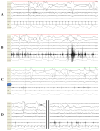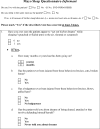Validation of the Mayo Sleep Questionnaire to screen for REM sleep behavior disorder in an aging and dementia cohort
- PMID: 21349763
- PMCID: PMC3083495
- DOI: 10.1016/j.sleep.2010.12.009
Validation of the Mayo Sleep Questionnaire to screen for REM sleep behavior disorder in an aging and dementia cohort
Abstract
Objective: To validate a questionnaire focused on rapid eye movement sleep (REM) sleep behavior disorder (RBD) among participants in an aging and dementia cohort.
Background: RBD is a parasomnia that can develop in otherwise neurologically-normal adults as well as in those with a neurodegenerative disease. Confirmation of RBD requires polysomnography (PSG). A simple screening measure for RBD is desirable for clinical and research purposes.
Methods: We had previously developed the Mayo Sleep Questionnaire (MSQ), a 16 item measure, to screen for the presence of RBD and other sleep disorders. We assessed the validity of the MSQ by comparing the responses of patients' bed partners with the findings on PSG. All subjects recruited in the Mayo Alzheimer's Disease Research Center at Mayo Clinic Rochester and Mayo Clinic Jacksonville from 1/00 to 7/08 who had also undergone a PSG were the focus of this analysis.
Results: The study sample was comprised of 176 subjects (150 male; median age 71 years (range 39-90)), with the following clinical diagnoses: normal (n = 8), mild cognitive impairment (n = 44), Alzheimer's disease (n = 23), dementia with Lewy bodies (n = 74), as well as other dementia and/or parkinsonian syndromes (n = 27). The core question on recurrent dream enactment behavior yielded a sensitivity (SN) of 98% and specificity (SP) of 74% for the diagnosis of RBD. The profile of responses on four additional subquestions on RBD and one on obstructive sleep apnea improved specificity.
Conclusions: These data suggest that among aged subjects with cognitive impairment and/or parkinsonism, the MSQ has adequate SN and SP for the diagnosis of RBD. The utility of this scale in other patient populations will require further study.
Copyright © 2011 Elsevier B.V. All rights reserved.
Figures




Comment in
-
Challenges in the assessment of dream enactment behavior.Sleep Med. 2011 May;12(5):429-30. doi: 10.1016/j.sleep.2011.02.001. Epub 2011 Apr 5. Sleep Med. 2011. PMID: 21470908 No abstract available.
References
-
- Boeve B, Silber M, Ferman T, Smith G. Validation of a questionnaire for the diagnosis of REM sleep behavior disorder. Sleep. 2002;25(abstr suppl):A486.
-
- Boeve B, Silber M, Ferman T, Smith G, Petersen R. Validation of a questionnaire for the diagnosis of REM sleep behavior disorder. Neurology. 2002;58(suppl 3):A509.
-
- Johns M. A new method for measuring daytime sleepiness: the Epworth Sleepiness Scale. Sleep. 1991;14:540–545. - PubMed
-
- Iber C, Ancoli-Israel S, Chesson A, Quan S Medicine, ftAAoS. The AASM manual for the scoring of sleep and associated events: rules, terminology and technical specifications. Westchester, IL: American Academy of Sleep Medicine; 2007.
-
- Rechtschaffen A, Kales A. A manual of standardized terminology, techniques and scoring system for sleep stages of human subjects. Los Angeles: Brain Information Service, Brain Research Institute; 1968. - PubMed
Publication types
MeSH terms
Grants and funding
LinkOut - more resources
Full Text Sources
Medical

